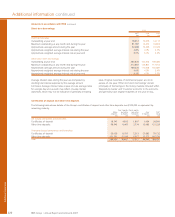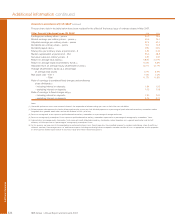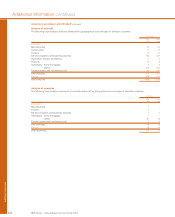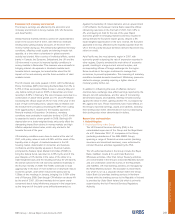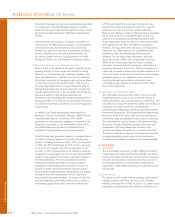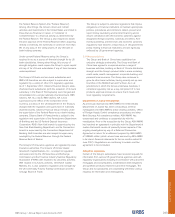RBS 2007 Annual Report Download - page 233
Download and view the complete annual report
Please find page 233 of the 2007 RBS annual report below. You can navigate through the pages in the report by either clicking on the pages listed below, or by using the keyword search tool below to find specific information within the annual report.
231
RBS Group • Annual Report and Accounts 2007
Additional information
Economic and monetary environment
The Group’s earnings are affected by the economic and
monetary environment in its key markets (UK, US, Eurozone
and Asia Pacific).
Global financial markets entered a period of unprecedented
strain in the second half of 2007, with reference interbank
lending rates spiking sharply and parts of the short-term
money market seizing up. This temporarily tightened monetary
conditions, affecting credit supply and denting investor risk
appetite, at a time when a slowdown in global economic
activity had started. After a series of individual efforts, central
banks in Canada, the Eurozone, Switzerland, the UK and the
US intervened in concert to improve liquidity conditions in
money markets in December. This measure was successful in
bringing interest rate spreads in interbank markets back
towards historic averages, but uncertainties about the full
impact on the real economy and the future evolution of debt
markets remain.
The UK interest rate cycle peaked in 2007, with the Monetary
Policy Committee (MPC) first hiking the Bank Rate from 5% to
5.75% in three successive 25bps moves in January, May and
July, before cutting it back to 5.50% in December and most
recently to 5.25% in February. The rate increases were due to a
combination of above-trend growth at 3.1% and CPI-inflation
exceeding the official target of 2% for most of the year on the
back of high commodity prices. Upside risks to inflation over
the medium-term prevailed, preventing the MPC from cutting
more aggressively in response to the liquidity squeeze in
financial markets in December. On balance, monetary
conditions were probably in restrictive territory in 2007, which
is expected to lead to slower growth in 2008. Sterling’s 6%
depreciation on a trade-weighted basis only partly offset the
dampening impact from strains in money markets and high
inflation-adjusted interest rates, which only started to fall
towards the end of the year.
US monetary conditions were close to neutral at the start of
2007, with policy rates on hold at 5.25% until the onset of the
liquidity crisis in August. A marked slowdown in the US
housing market, deterioration in consumer and business
confidence and the liquidity squeeze in financial markets
prompted the Federal Open Market Committee (FOMC) to
bring the federal funds rate down to 4.25% by the end of the
year. Despite a 10% decline in the value of the dollar on a
trade-weighted basis and the resulting stimulus for US exports,
the overall outlook for the US economy darkened materially in
the first two months of 2008. The FOMC continued to react
aggressively in the face of more evidence of downside risks to
economic growth, and further reduced the policy rate by
125bps at two meetings in January, bringing it to 3.00% at the
end of February 2008. Even though CPI-inflation ran above 4%
by the end of 2007, US bond markets did not seem overly
concerned about rising inflationary pressure in the longer term,
as the long-end of the yield curve shifted downwards too.
Against the backdrop of robust demand, and an upward trend
in CPI-inflation, the European Central Bank raised the official
refinancing rate twice in the first half of 2007, from 3.5% to
4%, and staying on hold for the rest of the year. Rapid
economic growth in emerging market economies resulted in
strong demand for Eurozone export goods, despite a 5%
trade-weighted appreciation of the euro. Overall, the Eurozone
appeared to be less affected by the liquidity squeeze than the
UK or the US, partly because domestic demand had been less
reliant on credit.
Asia Pacific was the most dynamic region in 2007, with
economic growth outpacing the rate of expansion recorded in
other regions. Exports remained the main driver of economic
growth, resulting in a large current account surplus, and
corresponding inflows of foreign exchange into the region.
Some countries in the region continued to manage their
currencies, to prevent appreciation. This loosening of monetary
conditions boosted domestic investment. Inflationary pressures
started to emerge, possibly requiring a tighter stance of
monetary policy further out.
In addition to influencing the level of effective demand
countries face, exchange rates affect earnings reported by the
Group’s non-UK subsidiaries, and the value of non-sterling
denominated assets and liabilities. Sterling remained strong
against the dollar in 2007, gaining another 1%, but slipped by
8% against the euro. These movements have mixed effects on
the Group’s reported earnings, assets and liabilities, boosting
their sterling-value when denominated in euro but depressing
their sterling-value when denominated in dollars.
Supervision and regulation
1. United Kingdom
1.1 Authorised firms in the Group
The UK Financial Services Authority (FSA) is the
consolidated supervisor of the Group and the Royal Bank.
As at 31 December 2007, 31 companies in the Group
(excluding subsidiaries of the ABN AMRO Group),
spanning a range of financial services sectors (banking,
insurance and investment business), were authorised to
conduct financial activities regulated by the FSA.
The UK authorised banks in the Group include the Royal
Bank, NatWest, Coutts & Co and Ulster Bank Ltd.
Wholesale activities, other than Group Treasury activities,
are concentrated in the Group’s Corporate Markets division
and are undertaken under the names of the Royal Bank
and NatWest. UK retail banking activities are managed by
the Retail Markets division. The exception is Ulster Bank
Ltd, which is run as a separate division within the Group.
Ulster Bank Ltd provides banking services in Northern
Ireland while the banking service to the Republic of Ireland
is provided by Ulster Bank Ireland Ltd which is primarily
supervised by the Irish Financial Services Regulatory
Authority.



